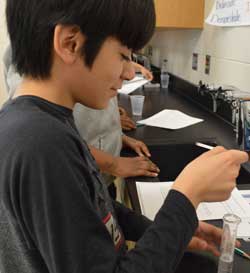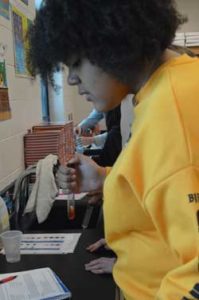Water Worldwide: Risk and Opportunity
Source: United Nations World Water Day |
A drop of water can go along way and pick up a lot on its journey. Valleywood Middle School students learned this while examining what’s in the water from wells in Byron Center, Rockford, Caledonia, Wayland, Kentwood and other area municipalities, as well as in tap water from their schools and homes.
Seventh-graders watched water brought in by science teacher Michael Faber turning colors, testing positive for iron and copper, and indicating pH levels as they shook up vials.
Students identified different minerals present in well versus tap water, noting the “hardness” of well water, and learned about how contaminants can have an identifiable source or come from runoff.
“It’s important we know what’s in the water so we are drinking healthy water,” said seventh-grader Alija Nukisic.
The science lab in Faber’s class provided a glimpse of what’s in area groundwater as students thought about impacts of human water usage and pollution. For World Water Day March 22, they discussed water supplies around the world and its scarcity.

Water Flows Through Classes
The lab was part of seventh graders’ extensive “Water is Life” study, a project-based learning cross-curricular unit, planned by English teacher Jane Van Hof. Students have also studied the watershed in Africa and read the book, “A Long Walk to Water,” by Linda Sue Park, about the Lost Boys of Sudan. They wrote research papers on “How does human activity influence water sustainability?”

They heard presentations from local experts including John Gorney, city of Kentwood Public Works director; Joanna Allerhand, environmental scientist from Groundswell; and Mike Roon, who is retired from the city of Wyoming and has built water systems in Ecuador.
The study will end with a field trip to the Grand Rapids Public Museum to see the Water’s Extreme Journey exhibit.
Faber’s class discussed contamination and pollution, as seen in Flint with lead and the Rockford area with PFAS recently. Seventh-grader Chad Horrell said it’s important to think about what’s in the water they drink and be aware of pollutants. “It could harm us health-wise and mentally,” he said.

“What happened in Flint was they had too much lead in their water and that caused people to get sick,” added seventh-grader Natalee Redd.
Students said they found differences in unsoftened well water and tap water when it came to mineral content. “It’s way foggier than tap water,” Chad said.
CONNECT











